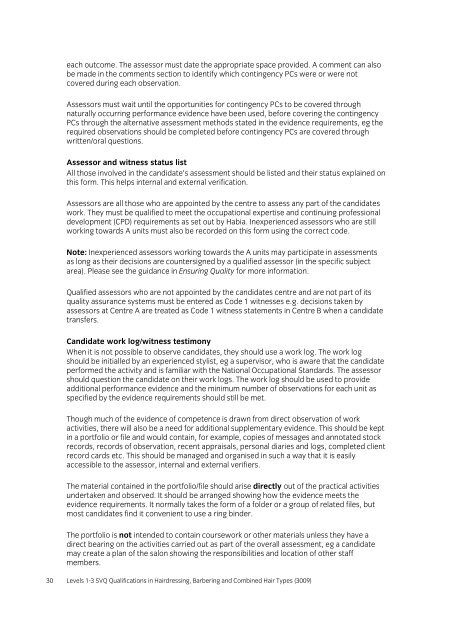3009 SVQ Assessment handbook v2 - City & Guilds
3009 SVQ Assessment handbook v2 - City & Guilds
3009 SVQ Assessment handbook v2 - City & Guilds
You also want an ePaper? Increase the reach of your titles
YUMPU automatically turns print PDFs into web optimized ePapers that Google loves.
each outcome. The assessor must date the appropriate space provided. A comment can also<br />
be made in the comments section to identify which contingency PCs were or were not<br />
covered during each observation.<br />
Assessors must wait until the opportunities for contingency PCs to be covered through<br />
naturally occurring performance evidence have been used, before covering the contingency<br />
PCs through the alternative assessment methods stated in the evidence requirements, eg the<br />
required observations should be completed before contingency PCs are covered through<br />
written/oral questions.<br />
Assessor and witness status list<br />
All those involved in the candidate’s assessment should be listed and their status explained on<br />
this form. This helps internal and external verification.<br />
Assessors are all those who are appointed by the centre to assess any part of the candidates<br />
work. They must be qualified to meet the occupational expertise and continuing professional<br />
development (CPD) requirements as set out by Habia. Inexperienced assessors who are still<br />
working towards A units must also be recorded on this form using the correct code.<br />
Note: Inexperienced assessors working towards the A units may participate in assessments<br />
as long as their decisions are countersigned by a qualified assessor (in the specific subject<br />
area). Please see the guidance in Ensuring Quality for more information.<br />
Qualified assessors who are not appointed by the candidates centre and are not part of its<br />
quality assurance systems must be entered as Code 1 witnesses e.g. decisions taken by<br />
assessors at Centre A are treated as Code 1 witness statements in Centre B when a candidate<br />
transfers.<br />
Candidate work log/witness testimony<br />
When it is not possible to observe candidates, they should use a work log. The work log<br />
should be initialled by an experienced stylist, eg a supervisor, who is aware that the candidate<br />
performed the activity and is familiar with the National Occupational Standards. The assessor<br />
should question the candidate on their work logs. The work log should be used to provide<br />
additional performance evidence and the minimum number of observations for each unit as<br />
specified by the evidence requirements should still be met.<br />
Though much of the evidence of competence is drawn from direct observation of work<br />
activities, there will also be a need for additional supplementary evidence. This should be kept<br />
in a portfolio or file and would contain, for example, copies of messages and annotated stock<br />
records, records of observation, recent appraisals, personal diaries and logs, completed client<br />
record cards etc. This should be managed and organised in such a way that it is easily<br />
accessible to the assessor, internal and external verifiers.<br />
The material contained in the portfolio/file should arise directly out of the practical activities<br />
undertaken and observed. It should be arranged showing how the evidence meets the<br />
evidence requirements. It normally takes the form of a folder or a group of related files, but<br />
most candidates find it convenient to use a ring binder.<br />
The portfolio is not intended to contain coursework or other materials unless they have a<br />
direct bearing on the activities carried out as part of the overall assessment, eg a candidate<br />
may create a plan of the salon showing the responsibilities and location of other staff<br />
members.<br />
30 Levels 1-3 <strong>SVQ</strong> Qualifications in Hairdressing, Barbering and Combined Hair Types (<strong>3009</strong>)
















